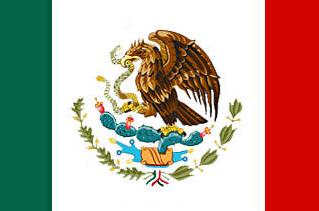Natural Home Cures Freeze Dried Nopal Powder Capsules - Nopal Cactus (Prickly Pear) Aztec Legends & Uses
(*) See References and Disclaimer at the bottom of the page.In the 14th century, the Aztec people were persecuted and cast out from other nations. As the legend goes, they believed their god, Huitzilopochtli, would guide them to a new settlement. He told them to look for an eagle perched on a prickly pear cactus, and that would be the sign they had reached the land they would build their empire.
 Mexico Flag |
Huitzilopochtli then commanded the Aztec people to search for a city to start their civilization. After 157 years of searching, called the "Wandering Period," the Aztecs finally arrived in the Mexican valley in the year 1325. There they witnessed a grand eagle of incredible beauty and colossal size resting on top of a nopal cactus. Captured in the great eagle's talons was a snake while the broad wings of the majestic eagle were beautifully extended facing the rising sun. |
Aztec and American Indian Uses of Nopal Cactus (Prickly Pear)
Since the Pre-Columbian period, the native people of the Americas, Aztecs, Coras, Chichimecs, Tepehuanes and Zacatecas have utilized the fruits and green stems of the Nopal cactus (Prickly Pear) as food.
Archeological research, using Carbon 14 dating techniques, found human coprolites (preserved feces) containing the remains of nopal dating back as far as 65 B.C. Another source of information about nopal's many uses by people in ancient times can be found in the journals of the missionaries who worked in the region, in the Spanish conquistador's messages to their leaders and in the native documents which survived destruction during the cultural cleanse ordered by Mexico's Spanish archbishop.
The Aztecs used nopal cactus (prickly pear) for food, building materials, making glue, firewood, strengthening mortar, stiffening cloth and for religious rituals.
The Aztecs also considered nopal cactus (prickly pear) a medicinal plant and used it to:
* Heal wounds
* Cure abscesses
* Strengthen the lungs
* Rid the body of intestinal parasites
* Increase milk production in mothers
* Promote the production & excretion of urine
American Indians living in the United States made use of nopal (prickly pear) cacti spines as needles for acupuncture. The Indians on the west coast believed that drinking the mashed up pulp of the nopal (prickly pear) cactus would make childbirth easier.
In ancient times, people from Spain who settled in Mexico used the peeled stems of nopal (prickly pear) cacti as a poultice or dressing for wounds and cuts.
Its many uses have survived into the modern age. During the 16th and 17th centuries, scurvy was a feared disease among men aboard sailing ships. They would look for foods that had a long shelf life as it was thought fresh food might ward off the disease. The actual cause of scurvy was not discovered until 1932.
In an 1809 Naval Chronicle document, nopal's use for treating scurvy on a British sailing ship was evidenced:
(Letter to the Editor of the Naval Chronicle)
MR. EDITOR,
The preservation of seamen from the scurvy, and even the cure of that disease, so far as it has yet been investigated, being best effected by fresh succulent vegetables, you will oblige me by the insertion of the enclosed letter from Mr. Charles Edmund, surgeon of his majesty's ship Russell…
J. ANDERSON. -- 1808.
His Majesty's Ship Russell, Madras Roads
SIR,
The plant, by the name of Kew Nopal, which you were so polite as to furnish me with to try its effects on scurvy, which was so general among the crew of his majesty's ship Russell after a cruise of three months with the men entirely confined to sea diet, I have the pleasure to say, proved so agreeable to those who had it given them in its raw state compared it to sorrel. And, I have no doubt it would have proved highly useful could it have been continued but owing to diarrhea, I was obliged to desist from giving the nopal or any other succulent vegetable. I considered the whole of the crew as being more or less affected with the scurvy and the necessity of their having vegetables with their boiled fresh meat; I made use of the nopal in a manner more admissible which was to put a portion every day in the coppers with their soup. I hope by the next time I have the pleasure of writing to you on the subject I will be able to speak of the benefit obtained as it is so easily taken care of by keeping it in the air. Therefore, I request you will furnish me with a further supply of nopal as we have nothing that will keep so long in a fresh, succulent stage.
I have the honor to be, sir,
Your obedient servant,
CHARLES EDMUND,
Surgeon on his majesty's ship Russell.

